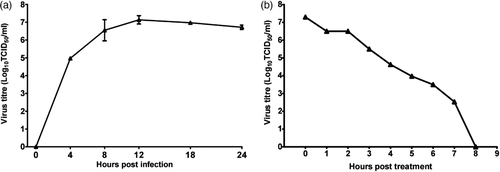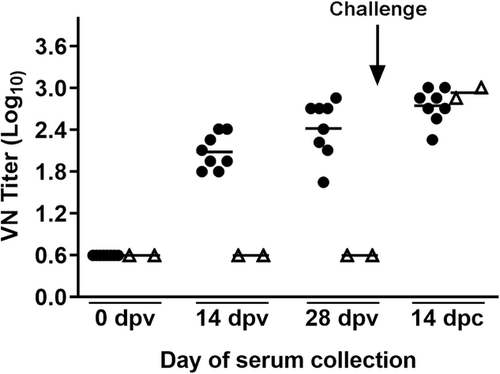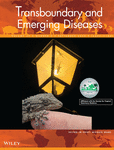Assessment of fitness of foot-and-mouth disease virus A IND 27/2011 as candidate vaccine strain
Abstract
Antigenic profiling of recent field outbreak strains of foot-and-mouth disease virus (FMDV) serotype A in India has revealed considerable antigenic drift from the vaccine strain, A IND 40/2000, necessitating the selection of a new strain. The complete genome sequence of A IND 27/2011 was analysed. Vaccine quality attributes of the new candidate strain including potency as an inactivated vaccine in cattle were evaluated. The capsid coding region of A IND 27/2011 showed variation at eight antigenically critical amino acid positions from that of A IND 40/2000. The strain suited well with traits required by a vaccine in terms of its adaptability to adherent and suspension cell line, its immunogenicity, and potency as an inactivated vaccine formulation in cattle. Complete protection was observed upon homologous virus challenge at 4 weeks post-vaccination. Taken together, these data demonstrate the suitability of A IND 27/2011 as an effective vaccine strain of FMDV serotype A.
1 INTRODUCTION
Preventive vaccination and intensive surveillance based ‘National FMD Control Programme’ is in effect in India since 2003 to bring down the incidence of the three endemic serotypes of foot-and-mouth disease (FMD) virus- O, A and Asia 1 (Pattnaik et al., 2012). Owing to very high genetic and antigenic diversity, one strain of FMDV often fails to confer protection against others within a serotype (Mattion et al., 2004). Therefore, high antigenic relatedness of contemporary field strains with the vaccine strain holds the key to the success of the vaccination programme. The vaccine should incorporate strains that are as highly immunogenic and cross-reactive as possible (Mumford, 2007).
Serotype A being antigenically the most heterogeneous among the Euro-Asiatic serotypes necessitates frequent changes in the vaccine strains (Bari et al., 2014; Kitching et al., 2005; Mahapatra et al., 2016; Mattion et al., 2004; Mohapatra et al., 2011). Of the three serotypes endemic to India, serotype A is antigenically and genetically the most heterogeneous. India had previously replaced serotype A vaccine strain during 2008 (Mohapatra et al., 2008). Antigenically divergent serotype A FMD virus strains circulating in India since 2012—2013 warranted selection of a new candidate vaccine strain to cover this diversity in the antigenic spectrum. A IND 27/2011 strain from a panel of eight strains was found to be the most suitable alternate vaccine strain considering its high antigenic relatedness with the field viruses (Mohapatra et al., 2018). However, the candidate vaccine strain needs to be thoroughly characterized to find a place in the commercial vaccine. The objective of the present study was to evaluate the vaccine quality attributes of the new candidate vaccine strain A IND 27/2011, in terms of its adaptability to suspension BHK-21 cells, growth kinetics, binary ethyleneimine (BEI) inactivation kinetics and vaccine efficacy in the natural host.
2 MATERIALS AND METHODS
FMDV serotype A IND 27/2011 selected as a vaccine candidate through vaccine matching (Mohapatra et al., 2018), was grown in Baby Hamster Kidney 21 (BHK-21) clone 13 monolayer cell line (ATCC) for virus assays. The virus at 6th passage (MP6) was serially passaged seven times in monolayer Razi BHK-21 cells for complete adaptation (MP6-R7). The Razi BHK-21 cell-adapted virus was then used to infect suspension BHK-21 cells. The virus adapted at 2nd suspension cell passage (MP6-R7-S2) was used as seed virus to prepare the antigen for vaccine formulation.
The complete viral genome was determined by amplification in seven overlapping Polymerase Chain Reaction fragments and sequencing by capillary sequencing using a 3130 DNA Analyzer (Applied Biosystems), as described previously (Mohapatra et al., 2011). The sequence reads were assembled using the EditSeq module of the Lasergene core suite 10 (DNASTAR, Inc., Madison, WI, USA). The complete genome sequence of candidate vaccine strain A IND 27/2011 was submitted to GenBank (Accession No. MN227144). Full genome nucleotide and complete coding region amino acid sequences of the vaccine strain A IND40/2000 and candidate vaccine strain A IND27/2011 were aligned using Clustal W algorithm (Thompson et al., 1994). Also, deduced amino acid sequence of the capsid coding region (P1) of 120 Indian serotype A genotype 18 virus isolates retrieved from GenBank and the local database of ICAR-DFMD were aligned to those of A IND 40/2000 and A IND 27/2011 (Supporting Information Figure S1). For phylogenetic analysis, complete capsid coding (P1) region sequences of 31 serotype A isolates sampled during 1977–2015 in India and of the vaccine strains retrieved from the GenBank were used (Supporting Inforamtion Figure S2). The evolutionary history was inferred using the neighbour-joining (NJ) method implemented in MEGA X software (Kumar et al., 2018). The General Time-Reversible model of nucleotide substitution with gamma-distribution among-site rate heterogeneity (GTR+G+I) was used to construct the tree. To assess the robustness of different nodes, bootstrap analysis was undertaken using 10,000 replicates of the data set.
The in vitro growth kinetics of suspension cell adapted A IND 27/2011 was studied using multistep growth curve analysis. Briefly, the BHK-21 suspension cells were infected at a moi of 0.01 with MP6-R7-S2 and incubated at 37°C. The virus was harvested at various time points up to 24 h and the titre at each time point was estimated by endpoint dilution method. The titer of the virus is expressed as mean tissue culture infective dose 50 per ml (TCID50/ml) from duplicate experiments.
Virus inactivation kinetics for candidate A IND 27/2011 was studied with 1 mM concentration of BEI, prepared by adding 2-bromoethylamine hydrobromide (BEA) to 0.7% NaOH and allowed to cyclize at 37°C for 60 min. The BEI was filter sterilized and added to the clarified virus at a final concentration of 1 mM. Inactivation of the virus was carried out for 20 h at 26°C with intermittent mixing. Samples were collected at hourly intervals and added sodium thiosulphate to a concentration of 2%, to hydrolyze BEI.
The BEI inactivated virus was chilled and sodium thiosulfate (2% final concentration) was added to hydrolyze BEI. The virus was precipitated by PEG 6000 at a final concentration of 8% w/v in the presence of sodium chloride solution (0.35 M). The precipitate was re-suspended in Tris-NaCl (pH 7.6) and centrifuged at 10,000 × g for 10 min to remove insoluble debris. The supernatant containing the virus was pooled and the concentration of virus particles (146S) was determined by spectrophotometric analysis of cesium chloride gradient fractions. Oil adjuvanted serotype A IND 27/2011 vaccine containing 10 μg (Tekleghiorghis et al., 2014) of inactivated FMDV antigen was prepared using Montanide ISA201 VG adjuvant (50% w/w) in each 2 ml dose. The vaccine was stored at 4 to 8°C until used.
FMDV sero-negative (for both structural and non-structural proteins) indigenous bull calves, approximately 6–12 months of age, were used in the immunization study. The calves were screened for FMDV structural antibodies using virus neutralization test (OIE, 2012) and non-structural antibodies using indirect ELISA (Hosamani et al., 2015). Animals were vaccinated by intramuscular route. Eight animals were vaccinated and two animals were kept as negative control. Pre-vaccination sera collection was done in all the animals. Serum was collected from these animals on 14 and 28 day post-vaccination (dpv). Animals were challenged on 28 dpv with 10,000 bovine infectivity dose (BID50) of cattle adapted virulent serotype A IND 27/2011 by intradermolingual (IDL) route. The challenged animals were scored for lesion up to 7 days and percentage protection was calculated. Animal showing vesicular foot lesions in at least one limb was considered as non-protected while no lesion in all the four limbs was considered as protected against challenge. The animal experimental protocol was carried out with the approval of the Institutional Animal Ethics Committee (IAEC) following the guidelines of Committee for the Purpose of Control and Supervision of Experiments in Animals (CPCSEA), Ministry of Environment, Forests and Climate Change, Government of India.
The quantitative VN test to detect FMD antibodies from the sera collected from animals before and after vaccination was performed following standard procedures (OIE, 2012) using the BHK-21 monolayer cell adapted A IND 27/2011 virus. Titres are expressed as the final dilution of serum where 50% of wells are protected.
Challenge study was conducted using homologous challenge virus as prescribed in Indian Pharmacopeia. The challenge virus was prepared by adapting the BHK-21 cell culture adapted A IND 27/2011 virus to grow in cattle tongue epithelium. The virus was serially passaged by IDL inoculation in FMD seronegative animals. At the 4th passage in cattle tongue epithelium, the virus was titrated by IDL inoculation. The titrated virus was used for the challenge experiment.
3 RESULTS AND DISCUSSION
Among the 26 global genotypes in serotype A, the exclusive presence of genotype 18 in the field has been documented in India, since 2001. Within genotype 18, VP359-deletion group and non-deletion group are co-circulating in the country (Das et al., 2016). Maximum likelihood phylogenetic analysis including P1 sequence dataset of serotype A virus placed A IND 27/2011 in the non-deletion group of genotype 18 similar to the existing vaccine strain A IND 40/2000, although in a distinct sub-group (Mohapatra et al., 2018). The A IND 27/2011 sequence revealed 6999 nucleotides encoding for 2333 amino acids similar to A IND 40/2000. The short fragment of 5′UTR was found to be similar in length (370 nucleotides) in both. However, the large fragment of 5′UTR excluding the poly(C) tract of A IND 27/2011 (714 nucleotides) was longer than in A IND 40/2000 (627 nucleotides) by 87 nucleotides. The 5′UTR sequence showed 85 nucleotide stretch deletion in the latter corresponding to the pseudoknot region downstream of the poly(C) tract, thereby deleting two out of four pseudoknots predicted for A IND 27/2011. Maintenance of at least two pseudoknots suggests in favour of the essentiality of the two pseudoknots for virus replication as predicted earlier (Mohapatra et al., 2009). The 3′UTR excluding poly(A) tail, of A IND 40/2000 (94 nucleotides) was longer by three nucleotides in A IND 27/2011 (91 nucleotides). In the capsid region, VP1 showed maximum variation at 12 positions, followed by VP3 at 11 and VP2 at eight positions, compared to A IND 40/2000. Among the 38 antigenically critical amino acid sites identified in monoclonal and polyclonal antibody mediated neutralization resistant mutants for FMDV serotype A (Das et al., 2016), eight (VP2 133T/D; VP3 59N/D and 139K/R; VP1 83S/D, 139A/P, 154I/V, 155A/T, and 170D/T) showed the difference between the two strains. Three out of the 8 positions showed differences located in the hypervariable VP1 βG-βH loop. Interestingly, a proline residue, which causes a kink in the secondary structure, was noticed at VP2 74 and VP1 139 positions in A IND 27/2011 instead of alanine observedin A IND 40/2000. The VP2 133, VP1 139 and 155 residues revealed identity between A IND 40/2000 and majority of serotype A genotype 18 field viruses. On the contrary, A IND 27/2011 revealed similarity to a majority of the field viruses at VP3 59, VP1 83, 154 and 170 positions. Based on the extent of identity observed at the antigenically critical residues among the vaccine strains and the field isolates, it is difficult to explain why A IND 27/2011 exhibited a superior antigenic match compared to A IND 40/2000.
The virus demonstrated a titer of Log10 7.3–7.5 TCID50/ml in BHK-21 suspension cell. Adaptation of A IND 27/2011 to BHK-21 suspension cell and associated charge gaining substitutions (E131–K in the βE-βF loop preceding αB helix and E82–K in the βC strand of VP2) on the capsid surface presumed to be instrumental in the adaptation process has been described earlier (Mohapatra et al., 2018). Growth kinetics revealed that virus growth peaks at 10–12 h post-infection and starts declining afterwards (Figure 1A).

Virus inactivation kinetics for serotype A IND 27/2011 showed complete inactivation by 8 h (Figure 1B). The inactivation kinetics is similar to the A IND 40/2000.
In the virus challenge test, all the immunized animals (n = 8) were completely protected (Table 1) with no secondary lesions. In the control group (n = 2), lesions were observed at the inoculation site from the second day after the challenge. Log10VN titer of more than 1.8 by 28 dpv was produced in all the immunized calves indicative of its strong immunogenicity. The VN antibody titers rapidly increased after the homologous challenge (Figure 2). In control animals, the neutralizing antibodies against the candidate vaccine strain were produced at high titers (Log10 2.86) on 14 day post challenge. Currently, in India, A IND 40/2000 is used in the vaccine formulations. Though the quantity of the antigen in μg per dose of the commercial vaccines is not available in the published literature, it is expected that the vaccine consists of antigen payload sufficient to provide 3PD50 which is a minimum requirement for vaccine batch release. In the absence of published literature correlating antigen payload (in μg) with PD50, we conducted a proof-of-concept study using 10 μg antigen per dose as described by Tekleghiorghis et al. (2014). A dose response study will be carried out in our future studies to establish the protective antigen payload in the vaccine.
| Group | Animal ID | Foot Lesions | Status of Protection | Percent protection |
|---|---|---|---|---|
| Vaccinated | A-205 | None | Yes | 100 |
| A-249 | None | Yes | ||
| A-251 | None | Yes | ||
| A-252 | None | Yes | ||
| A-253 | None | Yes | ||
| A-254 | None | Yes | ||
| A-255 | None | Yes | ||
| A-257 | None | Yes | ||
| Unvaccinated control | A250 | All 4 limbs | No | 0 |
| A256 | All 4 limbs | No |

In conclusion, the candidate strain A IND 27/2011 demonstrated all the traits of a vaccine as required for scaling up of the antigen production. Considering that the current vaccine strain, A IND 40/2000 has a poor antigenic relationship with the recent field isolates, the study suggested that the current vaccine strain could be replaced.
ACKNOWLEDGEMENTS
Authors thank the Director, ICAR-Indian Veterinary Research Institute (IVRI) Izatnagar, and the Director, ICAR- Directorate on Foot and Mouth Disease (DFMD) Mukteswar, for facilitating this study. Authors also acknowledge SEPPIC-Air Liquide Healthcare Specialty Ingredients for providing Montanide ISA-201 VG adjuvant.
CONFLICT OF INTEREST
All authors declare no conflicts of interest.




